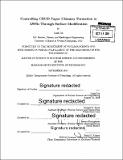Controlling CRUD vapor chimney formation in LWRs through surface modification
Author(s)
Lin, Leigh
DownloadFull printable version (13.50Mb)
Alternative title
Controlling Chalk River Unidentified Deposits vapor chimney formation in Light Water Reactors through surface modification
Other Contributors
Massachusetts Institute of Technology. Department of Nuclear Science and Engineering.
Advisor
Michael P. Short.
Terms of use
Metadata
Show full item recordAbstract
Fouling has been a persistent problem for fluid-solid interfaces, varying from heat exchangers to ship hulls. In nuclear power plants, buildup of CRUD can accelerate corrosion, increase pressure drops, cause axial power shifts, and increase radiation dose to workers. In this experiment, we studied the effect of induced microcavity and micropost patterns on CRUD morphology at atmospheric pressure. Samples with various pitches of microcavities and microposts were boiled in simulated PWR coolant. The effect of heat flux on CRUD formation was also examined. The experiments support previous theories that subcooled nucleate boiling is enhanced at microcavities, and that CRUD deposition is promoted at those sites. A thin ring of particles, less than a micrometer in width, was seen around most microcavities even when the surrounding areas were crudded. However, some of the samples with microcavity pitches 50 pm and smaller experienced a pattern of clean and crudded areas, with the region around the microcavities free of CRUD more often than not. A theory is put forth that this is caused by interfering forces due to bubbles collapsing. The micropost samples showed substantial CRUD growth, particularly for the sample subjected to a high heat flux. The results of this experiment could have major implications for development of a self-cleaning material for heated surfaces.
Description
Thesis: S.M., Massachusetts Institute of Technology, Department of Nuclear Science and Engineering, 2014. Cataloged from PDF version of thesis. Includes bibliographical references (pages 105-112).
Date issued
2014Department
Massachusetts Institute of Technology. Department of Nuclear Science and EngineeringPublisher
Massachusetts Institute of Technology
Keywords
Nuclear Science and Engineering.